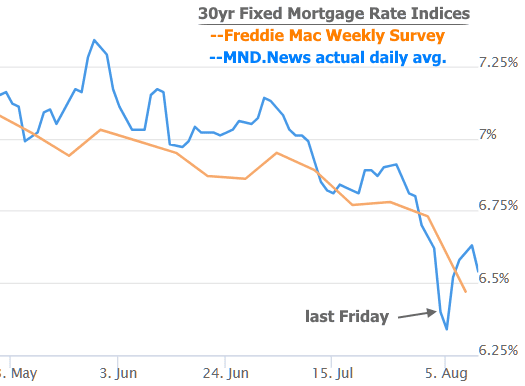This week was a wild ride in the mortgage world! Rates plummeted to their lowest levels in over a year, only to soar back up at the 3rd fastest pace in almost two years. It’s like the rollercoaster you didn’t ask for, but here we are!
Monday kicked off with global financial markets doing their best impression of a yo-yo. Some folks pointed to recession fears after last week’s meh jobs report, but it quickly became apparent that there was more to the story—cue the dramatic music.
Enter the carry trade, an obscure financial strategy that sounds like something out of a spy movie. It’s all about borrowing money in a currency with low interest rates and investing it in a country with higher returns. The Yen (or USD/JPY when we’re talking exchange rates) is the poster child for this scheme. Lately, it had fueled a shopping spree in the US equities market, but last week’s drama caused a sharp turn in USD/JPY and led to a fire sale of assets bought through the carry trade.
At first, this chaos was fantastic news for US interest rates. The global turmoil sent investors flocking to the US bond market, where more demand means lower rates (yay!). Monday morning brought an amazing drop to the year’s lowest rates, which was particularly impressive considering rates had already plummeted the previous Friday.
But all good things must come to an end. After the initial euphoria, rates did nothing but shoot up from Tuesday through Thursday afternoon. It was a dramatic turnaround, with the average 30-year fixed rate jumping nearly 0.3% in just three days—making it the third biggest 3-day jump of the year. Yikes!
Adding fuel to the fire were some upbeat economic reports, like ISM’s Services Index and US Jobless Claims, which managed to push back against the doom-and-gloom recession vibes from last week’s data.

The Jobless Claims chart above shows non-seasonally adjusted figures. Usually, we don’t look at this data in such a raw form, but the post-COVID years have thrown a wrench into the usual seasonal adjustments. By overlaying multiple years, we get a clearer view of trends. The recent spike in the red line had everyone worried about labor market weakness, but this week’s data eased those concerns. Good news for the job market, but not so great for mortgage rates.

Finally, on Friday, rates inched down a bit, but not enough to erase much of the week’s damage. Compared to last Friday, we still ended the week with higher rates. Don’t be fooled by some media outlets quoting Freddie Mac’s weekly survey claiming rates were lower this week—they just averaged the data from Thursday through Wednesday, including last Friday’s drop, which we already covered.

Looking ahead, all eyes will be on the Consumer Price Index (CPI)—one of the heavyweight economic reports that can move markets in a big way. CPI is crucial for determining the Fed’s next move regarding rate cuts. If CPI comes in higher than expected, it might not immediately change the Fed’s course, but with another CPI and a jobs report still to come before the next Fed meeting, anything could happen. If all three reports are rate-friendly, we might see new long-term lows before September’s Fed announcement. But if they all come in hotter than expected, rates could bounce right back to early July levels.
Buckle up—it’s going to be an interesting ride!
